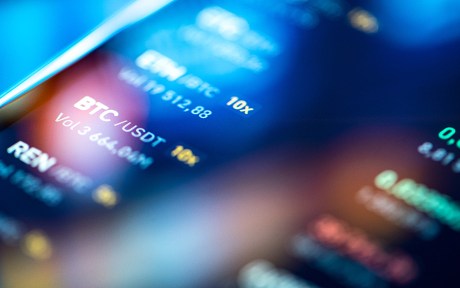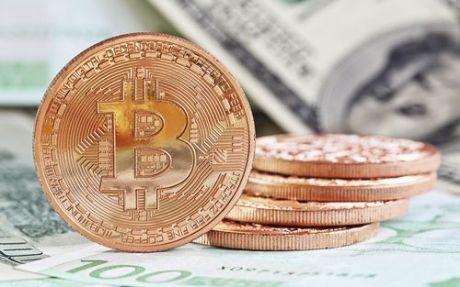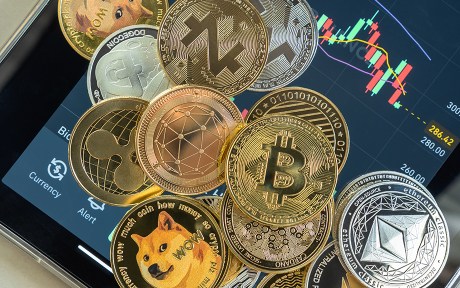
Spot bitcoin exchange-traded products (ETPs) began trading in the U.S. on January 11, 2024. For investors, these ETPs purport improved liquidity and price efficiency, and more convenient access to bitcoin trading compared to other means of trading bitcoin in spot markets. Proponents also cite bitcoin holdings as a portfolio diversification opportunity due to historically low correlation with traditional financial securities. Others argue that bitcoin remains a speculative asset and that ETPs increase its interconnections with the traditional financial system. In this post, we examine the initial performance, trading costs, and price efficiency of spot bitcoin ETPs in the U.S.
Introduction of Bitcoin ETPs in U.S.
The Securities and Exchange Commission (SEC) approved the listing of a number of bitcoin ETP applications on January 10, 2024. Spot bitcoin ETPs are pooled investment vehicles that track the price of the underlying securities, with shares that can be traded like a stock. Furthermore, ETP investors receive protection under SEC regulations in areas such as disclosure, fraud, and manipulation. Various types of bitcoin ETPs (such as exchange-traded funds or ETFs and exchange-traded notes or ETNs) have been trading in other countries (such as Australia, Canada, and the European Union) for some years.
Are Bitcoin ETPs Likely to Lower Trading Costs?
In general, ETFs (that are structurally similar to ETPs) may improve liquidity by making it easier to trade the underlying assets but can also crowd out liquidity in pre-existing venues for trading the underlying asset. Based on analysis of stock and bond ETFs, there is mixed evidence on whether the net effect is positive, and some evidence of a negative effect on the underlying bonds during crises.
Prior to the launch of bitcoin ETPs, retail traders could gain exposure to spot bitcoin through a number of channels. As a first option, investors could purchase bitcoin on a centralized crypto exchange (CEX) and use the exchange as a custodian for the asset. A second option was for investors to trade bitcoin on decentralized exchanges (DEXs) and retain the bitcoin in their non-custodial digital wallet (although, this is technically challenging as it involves managing cryptographic keys). Finally, investors could purchase shares in Grayscale Investment’s bitcoin trust (GBTC), which was a closed-end fund without a redemption mechanism, or bitcoin futures ETFs, which hold calendar futures traded on the Chicago Mercantile Exchange (CME). The futures ETFs must roll their underlying contracts on expiration, dissipating the returns of long-term holders.
The all-in costs of trading bitcoin may include fees charged by the venue for executing trades, custodial fees required to keep the private keys of bitcoin safe, and the bid-ask spread charged by market makers. There are additional fees that differ according to the venue. On CEXs, traders incur additional settlement costs for transferring bitcoin from the exchange to an investor’s non-custodial wallet and when depositing to or transferring funds from the exchange. On DEXs, traders pay so‑called gas fees for processing transactions on a blockchain. Lastly, ETPs charge expense ratios for managing the funds that are subtracted from its returns.
What are typical costs for investors trading bitcoin on CEXs? While data on custody fees are hard to come by, media reports indicate that a major custodian earned a fee worth 0.07 percent of assets. Regarding settlement expenses, both bitcoin and fund transfer costs are high and differ by exchange (see here, here and here). Trading fees on a CEX can also vary significantly depending on the asset and order size. For example, research shows that on Binance (the largest CEX), total fees for trading the bitcoin-ether pair (where ether is the native token of the Ethereum blockchain) can range from fewer than 20 basis points to almost 160 basis points (as shares of the average spread). Institutional traders may have more leverage negotiating fees with the exchange. The bid-ask spread, when measured as a percent of the average of the bid and ask prices, also varies substantially across exchanges, from as little as 1 basis point to 70 basis points or higher over the past two years.
When investors trade bitcoin on DEXs, research indicates that trading costs are similar to those on CEXs.
Finally, expense ratios on GBTC or bitcoin futures ETFs ranged from 2 percent for the former to 0.95 percent for the largest bitcoin futures ETF (in addition to expenses incurred from replacing futures contracts when they expire), according to Morningstar.
By comparison, for the newly listed spot bitcoin ETPs, expenses typically range (at the time of writing) from 0.2 percent to 0.5 percent, with converted GBTC an outlier at 1.5 percent, but still lower than the non-ETP alternatives previously discussed. While ETPs may have narrow bid-ask spreads, there is likely to be considerable variation across different ETPs depending on their trading activity. Moreover, recent research indicates that bid-ask spreads have been lower on CEXs since the launch of the ETPs, narrowing the ETPs advantages relative to CEXs. Finally, there is little public information on custodial fees for the bitcoin ETPs. Coinbase is the custodian of many and this concentration could give it greater price setting power.
Is Price Efficiency Likely to be Greater for Bitcoin ETPs?
In prior periods, GBTC and the bitcoin futures ETFs typically did not track bitcoin spot prices well. Between early 2021 and August 2023, the chart below shows that the GBTC trust traded at a steep discount to its Net Asset Value (NAV) due to the lack of a redemption mechanism. The discount has narrowed after August 2023, when investors began to anticipate GBTC’s conversion from a closed-end trust to an ETP. For the futures ETFs, the process of rolling over futures contracts often leads to discrepancies with bitcoin spot prices.
GBTC Trust Traded at a Steep Discount to its Net Asset Value (NAV)
Premium/Discount Percent
Note: The chart shows the difference between the price of the Greyscale Bitcoin Trust (GBTC) and its net asset value (NAV) between March 1, 2021 and March 14, 2024.
Relative to the trusts and the futures ETFs, spot bitcoin ETPs are expected to track underlying spot prices more closely as shares can be added and redeemed with higher frequency than alternatives. Indeed, while the spot bitcoin ETPs sometimes trade at a slight premium to their NAV on average (see chart below), the gap is on average 13 basis points versus 25 percent for the GBTC trust between March 2021 and December 2023.
Spot Bitcoin ETPs Trade Close to Their Net Asset Value (NAV)
Premium/Discount Percent
Notes: The chart shows the average difference between the price of the newly launched spot bitcoin ETPs and their net asset values (NAVs) between January 11, 2024 and March 14, 2024, when the ETPs started trading. The tickers of these ETPs are IBIT, FBTC, EZBC, ARKB, HODL, BTCO, BRRR, BITB and BTCW.
A potential inefficiency for bitcoin ETPs results from their so-called cash-create requirement, as compared to the in-kind method used by many other ETFs to create shares. The cash-creation method implies that ETP participants must fund share purchases with cash on-hand, the cost of which may be ultimately passed onto market makers and end investors.
Performance of Bitcoin ETPs So Far
When stocks are included in ETFs, their volatility appears to increase due to an increase in short-horizon trading that the ETF facilitates. At the same time, bitcoin’s price volatility is known to be multiples of that of stocks, and the introductions of ETPs may reduce the volatility of bitcoin prices if the ETPs receive large inflows, especially from institutions. The chart below shows trading volumes of bitcoin ETPs compared to other vehicles for spot bitcoin trading. Spot bitcoin ETP volumes are small compared to the total spot and futures market in the U.S., averaging about $3 billion per day, as compared to more than $40 billion for perpetual futures, the most liquid bitcoin market.
Spot Bitcoin ETP Trading Volumes are Smaller than Alternatives
Billions of U.S. dollars
Note: The chart shows the average daily traded volume for alternative bitcoin trading venues (perpetual and non-perpetual, futures, spot trading with and without ETPs, and Coinbase) between January 11, 2024, when the ETPs started trading, and March 13, 2024.
In spite of the relatively small trading volumes so far, net inflows into spot bitcoin ETPs year-to-date are over $12 billion. In turn, these flows may have contributed to bitcoin’s rapid price appreciation in 2024 to-date, creating the potential for further inflows into these products. For example, many institutional investors pulled back from crypto asset investments in 2023 due to the concerns about fraud and high levels of operational hurdles, but the high inflows into the spot bitcoin ETPs suggest they have found these products an attractive way to avoid these operational hurdles.
While adoption of spot bitcoin ETPs has been growing, there are some prominent holdouts. Some brokerages have stated that they will not support the trading of these ETPs, while others are still conducting compliance reviews of these products. While increasing flows are expected to improve liquidity, greater adoption may draw more speculative trading to the bitcoin derivatives market (where dealers will go to hedge their bitcoin ETP exposures), potentially increasing the volatility of the ETPs.
Summing Up
Bitcoin ETPs have thus far demonstrated some potential for greater liquidity and price efficiency, although their volumes have been lower than other bitcoin trading products. Looking ahead, market observers expect additional new bitcoin products, such as funds that add derivative overlays to existing spot bitcoin ETPs. Several fund managers have submitted applications to launch ETPs holding ether, the second largest crypto asset by market capitalization, though it is far from certain whether they will be approved.

Ken Armstrong is a policy and strategy specialist in the Federal Reserve Bank of New York’s Supervision Group.

Asani Sarkar is a financial research advisor in Non-Bank Financial Institution Studies in the Federal Reserve Bank of New York’s Research and Statistics Group.

Leslie Conner Warren is a senior specialist in the Federal Reserve Bank of New York’s Supervision Group.
How to cite this post:
Ken Armstrong, Asani Sarkar, and Leslie Conner Warren , “Do Exchange‑Traded Products Improve Bitcoin Trading? ,” Federal Reserve Bank of New York Liberty Street Economics, May 28, 2024, https://libertystreeteconomics.newyorkfed.org/2024/05/do-exchange-traded-products-improve-bitcoin-trading/
BibTeX: View |
Disclaimer
The views expressed in this post are those of the author(s) and do not necessarily reflect the position of the Federal Reserve Bank of New York or the Federal Reserve System. Any errors or omissions are the responsibility of the author(s).












 RSS Feed
RSS Feed Follow Liberty Street Economics
Follow Liberty Street Economics